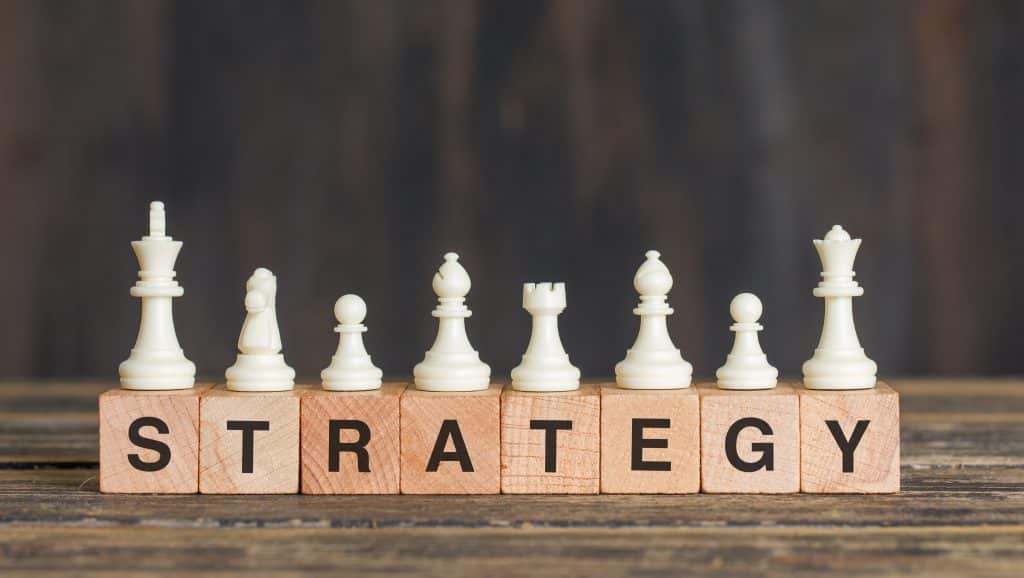Table of Contents
Introduction
In this article we’re diving into brand strategy 101 – the elements, deliverables and processes. By the end, you’ll have a much better understanding about the engine that drives successful brands, and the insights to further develop the strategy in place for your own brand.
You may have heard this old saying – “perception is reality”. Not only is this true, it very much aligns with the primary reason why people invest into premium brand assets like a quality logo and a professional website – they do it to better influence people’s perception. While influencing people’s perception certainly requires you to have premium brand assets (ex. a premium logo, strong brand message, professional website, superior products/services, etc), the true essence of your brand is actually much deeper than the visual elements that bring it to life.
Building a brand truly is about influencing the perceptions of your audience to make your business more appealing to them. The most ideal way to achieve this is by developing the intangible elements of your brand alongside an effective brand strategy framework.
In today’s marketplace, audiences are placing a demand on brands to connect with them in a way that feels human, and still communicates excellence. If they can’t get that from your brand, they’ll get it from another brand. If you want to build your brand strategy in a way that connects to your audience, this brand strategy framework will show you how.
What Is Brand Strategy?
Brand strategy is a long-term plan for what a brand will build its reputation on, and the method they’ll use to build that reputation. If your strategy is successful, your brand will claim a position in the mind of your audience about the value and experience that it offers. As a result, a certain segment of your audience will choose your brand over your competitors. More and more brand builders, bootstrapped entrepreneurs and marketplace moguls are beginning to realize that for their brand to have a strong chance of success, some critical questions need to be answered. Some of these questions include;
- Why are we here?
- Who are we here for?
- Where are we going?
- What are we committed to?
- How are we different?
- Why should they care?
- What's our personality?
- What's our message?
We mentioned earlier that having premium brand assets to bring your brand to life is a requirement, especially in this digital age we live in today. However, a premium look and feel for your brand won’t answer these questions for you. In fact, the better way to develop premium brand assets is by answering these questions first, and then creating visuals that correspond with your answers.
Believe it or not, the answers to the questions listed above matter more to your brand than the way it looks, even if your logo and web design makes you look like a billion-dollar brand.
Why Do You Need A Brand Strategy?

How your brand looks doesn’t tell your audience what they should understand or remember about your brand. This is the information your audience truly needs when they’re deciding of which brand to choose. As consumers we want our problems to be removed as quickly and as painlessly as possible. This need for a solution, doesn’t lead us to brands that look good. It leads us to brands that can demonstrate their understanding of our problem, brands that address our pain points, and brands that speak to us in a way that feels familiar.
If you decide to build a brand, in essence, you’re building an entity that will connect YOUR products/services to YOUR audience, through human engagement. This is why your brand needs a strategy.
There are many qualified voices providing thought-leadership around the concept of branding, and many of the quotes from these leaders are worth considering in trying to answer the question – why do you need a brand strategy?
Here are two quotes that we resonate with and strongly believe in;
Your brand is what people say about you when you're not in the room
Jeff Bezos
A brand is not what you say it is, it's what they say it is
Marty Neumeier
We dive deeper into the reason why these are our two favourite quotes about branding inside the High-Performance Branding content that we give away for free – you can request access here.
The question we’d love for you to consider is this – what strategy do you have in place to control the narrative of your brand inside of rooms that you’re not in?
This question alone should significantly increase the demand you place upon an effective brand strategy. Ultimately, a brand strategy is a customized plan for the optimal expression of your brand, that helps you shape the perceptions of the minds in your intended audience. It helps you to control (as best as possible) what people think and feel about your brand, and the experience that it offers.
A successful brand strategy will cause your audience to feel an attachment, a connection, a desire, or an affinity towards your brand that they wouldn’t have otherwise felt without carefully positioned, structured and sometimes even personalized brand messages.
Brand Strategy VS. Brand Deliverables
The best way to communicate the interdependence of these two distinct and very important brand assets is with a short story that highlights an analogy. Let’s compare building your brand to going on a backpacking tour in a foreign country through some dangerous terrains. Let’s also say you’ve never been backpacking before, and it’s your first time ever going to this country. You’ll probably agree that there are some very essential items that you’re going to need for this trip. Things like hiking gear, hiking boots, wet weather protection, thermal gear, a nifty backpack equipped with hiking trinkets, etc. These items can be compared to your brand deliverables.
Your Brand Deliverables Should Include:
- Premium Logo
- Colour Palette
- Font Kit
- Brand Message
- Tone of Voice
- Brand Identity Guidelines
- Stationary Materials
- Business Card
- Social Media Banners & Highlights
- Professional Website
But you’ll probably also agree that there are some very essential questions you’ll need answered before you leave to start this journey.
You’d want to sit down with someone who knows the route you’re about to travel on very well. Someone that could give you a detailed roadmap, navigate the route/roads to use, the areas to avoid, the most efficient times to travel, and some insightful techniques to make the journey less daunting.
These carefully curated instructions that detail your way forward can be compared to your brand strategy (a mapped-out plan of brand expression that the brand manager can follow to shape the perception of the brand in the mind of the audience).
Your Brand Strategy Should Include:
- Detailed Audience Persona's
- Competitive Analysis
- Differentiation & Positioning Strategy
- Human Brand Persona & Personality
- Brand Voice
- Communication Framework
- Brand Message
- Brand Storytelling Framework
- Marketing Strategy
The Brand Strategy Framework

Developing any of the necessary strategic elements at the wrong point in time, or overlooking any of the required considerations, will likely result in a misaligned brand. Having a clearly defined framework to follow as you build your brand will greatly reduce (if it doesn’t eliminate completely) the risks of misalignment.
Building a brand is much like building a house. It requires certain building blocks to be placed in a certain order to ensure a strong foundation.
In this next section, that’s exactly what we’re going to cover in detail – a strong brand strategy framework that you’ll be able to follow to build your brand.
The first and most important step depends heavily on who is leading the brand. This is where you'll want to uncover the meaning of 'their' brand from 'their' perspective. Through the most ideal discovery process for your situation, you'll want the leaders of the brand to agree upon the following; Why the brand exists
- Where it's going
- What it's committed to
- How it will behave
We've all heard the age-old saying - "know your audience". It's neither new nor uncommon, and yet, very few brands are built with the requisite level of understanding to truly get into the heads and the hearts of that group of people. So much of your brand stems from the detail of who your audience is, and the different audience segments. It's vitally important to take the time and apply great levels of focused effort to better understand them.
Your target market already has options for similar solutions in the marketplace through your competitors. If you end up offering the exact same solution, or a less refined version, you'll be at a two-fold disadvantage.
On one hand, your competition will already have a more established brand presence and brand awareness than you. On the other hand, you'll run the risk of presenting a bland and less refined option for the consumers in your space.
It's in your best interest to take some time to determine what your audience already has access to in the marketplace.
Utilizing the clarity you've gained of your competitive landscape through research, and your competitor analysis, you can begin to identify gaps in the market.
Understanding the pain points of your consumers and the gaps in the solutions that are currently available to them offers you an extremely competitive advantage from a branding perspective. It allows you to choose your niche advantage (the thing you'll build your reputation on) and get to work on developing your very own strategic positioning.
Once you've aligned your differentiation strategy with your target market, you can begin to clarify the following;
- What do you do?
- Who do you do it for?
- What makes you different from the existing options?
- What added benefit and/or value do you bring to your audience?
The answers to these questions will help you to clearly define your positioning strategy.
This framework was developed by a psychiatrist named Carl Jung in the early 20th century. It provides a tool for us brand builders to better understand the personality of our audience (who they are) and be better equipped to appeal to them. Even if you've never heard about archetypes before, or you've heard about them but never utilized the framework to help you refine your communication strategy, rest assured that not only is it fool-proof to use, but it will be a great help to you almost immediately - here's a great resource for you to learn more about that framework.
While your brand archetype sets in place the foundation for your broader brand personality, it's only a framework and a starting point. To bring your brand to life in such a way that it begins to feel to your audience like a real person they can connect with, you need to insert elements of realism. These can include attitudes on the industry, opinions on the world, and broader beliefs. These realistic elements help to add detail and believability to your brand personality.
One of the most effective tools of expression for any brand is the tone of voice in which its message is delivered. All the characteristics you've defined thus far in the development of your brand persona, can be further enhanced by carefully selecting a tone of voice that emphasizes the characteristics that your brand embodies. If you're able to deliver a tone of voice that feels familiar to your audience, or represents the feeling they're searching for, then they will be far more open to the message that your brand is communicating.
Once you've crafted a truly human brand persona and an intimate knowledge of your audience as well as what they want, you're best equipped to create a brand message that will land in the hearts and minds of your audience. Armed with an understanding of their challenges, their pain points, their hopes, their dreams, their desires, and their fears - your brand message will carry everything necessary to resonate on a deep, human level.
Every audience is always thinking to themselves "what's in it for me"? When you really understand your audience (by following the steps in this framework), you'll be able to tell stories that mirror your audience in a very authentic way.
Your stories will align with the journey that they're on, where they're coming from, where they're going to, and the challenges that they're facing along the way. This will be the reason that your audience grows to be completely tuned in to the message that your brand represents.
If you're following this framework, then this is where branding crosses over from the side of strategy development to the side of your visual identity. Following this framework means that your designer is presented with invaluable strategic information and direction that empowers them to create unique, authentic, and world-class designs. They'll be working from a vantage point that is simply not available to non-strategic designers, which always translates to a much better visual identity and a clear competitive advantage.
At this stage in the game, you know who you are, why you're here, why you're different, and what should matter to your audience. You've also defined the method and the approach you're going to take to get your message into the market and in front of your audience.
Now it's time to define the platforms and the channels you'll use to get your message out there. This again is all about understanding your audience, where they congregate, and where they're most likely to be open to your brand messaging.
Beyond The Brand Strategy Framework

So now you have your brand strategy and your brand’s visual identity has been developed. Your brand is ready to be introduced to the world. You’ve prepared your brand with the gear it will need for the journey and the strategic roadmap it should take to reach its desired location. With everything that you’ve invested thus far, you are certainly way better equipped than 99% of brand builders, bootstrapped entrepreneurs and market moguls who set out on this journey with much less than what we’ve presented in this article. However, it’s only here and now that your journey truly begins.
Rome wasn’t built in a day, and neither are successful brands. As the chief architect of your brand, you must be disciplined in following the strategic roadmap we’ve created together, consistently. Make it a priority to weigh yourself against the checkpoints outlined in this article and make necessary adjustments to keep yourself aligned as best as possible. As you begin to introduce your brand to the world, you enter the first of three A’s in the process of growing your brand.
The first A is called Brand Awareness:
The first task is to plant your brand into the consciousness and subconsciousness of your intended audience. This is where buyers begin to consider your brand. Depending on several factors, they will choose to move into the second A in the process of growing your brand.
The second A is called Brand Adoption:
At this point, awareness is established, and your brand must work hard to maintain excellence in the onboarding sequence and nurturing process to truly convert people from awareness into adoption. Generating one-off business is not easy and generating repeat business requires excellence and commitment to the values you have expressed.
The third A is called Brand Advocates:
As your brand begins to serve its adopters, delivering on the value that it promised, the goal is to develop your customers into brand advocates. These are people who love the value you provided so much that they literally become mini marketers on your behalf.
In writing this article we decided not to try and convince you of the value and impact of social proof. We decided to trust that you’re already convinced of its power and simply say that the social proof your brand generates from loyal customers is considered by many to be the highest honour your brand can achieve. It’s one of the foundational principles of influence because “the tendency is to see an action as more appropriate when others are doing it” – Robert Cialdini When you do everything in your power to achieve brand advocacy, your rewards will multiply.
Conclusion
Building your brand will not happen overnight, neither will it happen as a one-time event. It will require careful consideration and consistent application of a strategic plan. This plan is the deliverable of a brand strategy. Without one, you may find yourself aimlessly wandering, drifting from seasons of feast into seasons of famine, and unsure of how to build sustainable growth.
Take the time to define the brand strategy for your brand. Understand who the audience is, why your brand will be different than your competitors, and then devise the method you will use to get that communication out into the marketplace in a way that your audience is going to resonate with.





